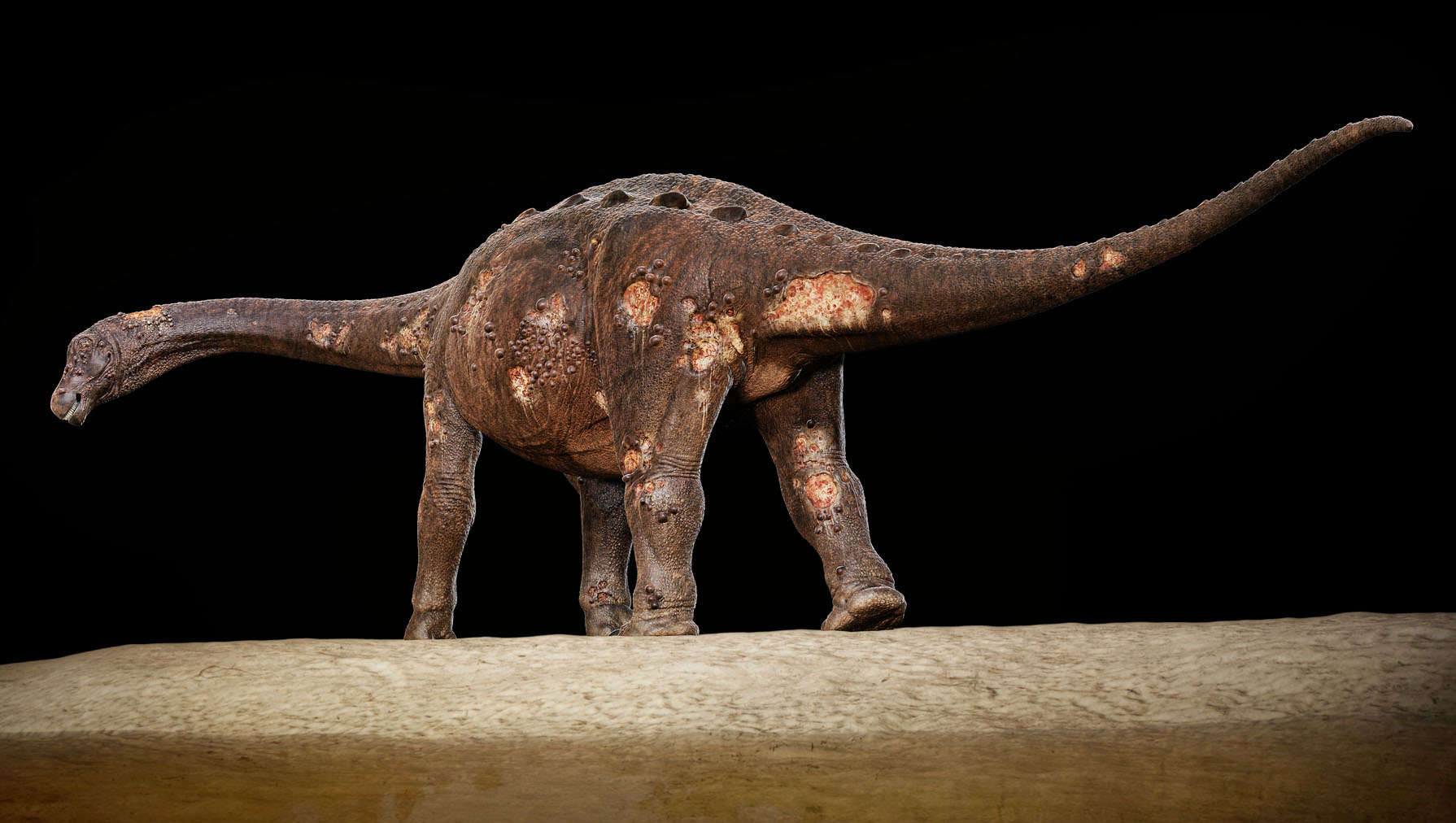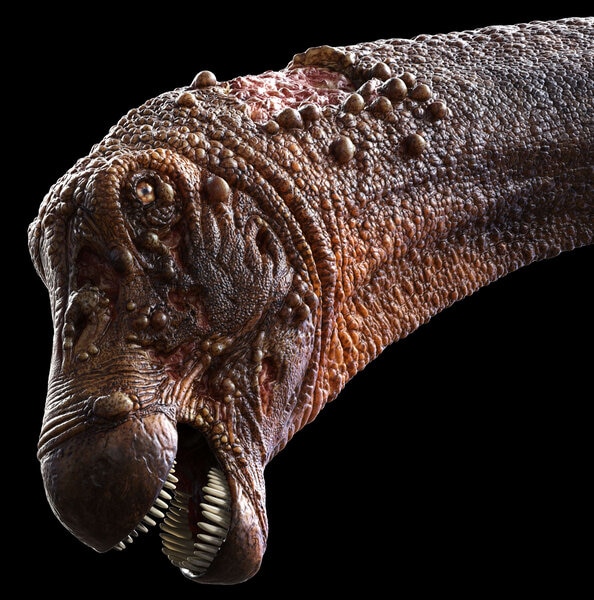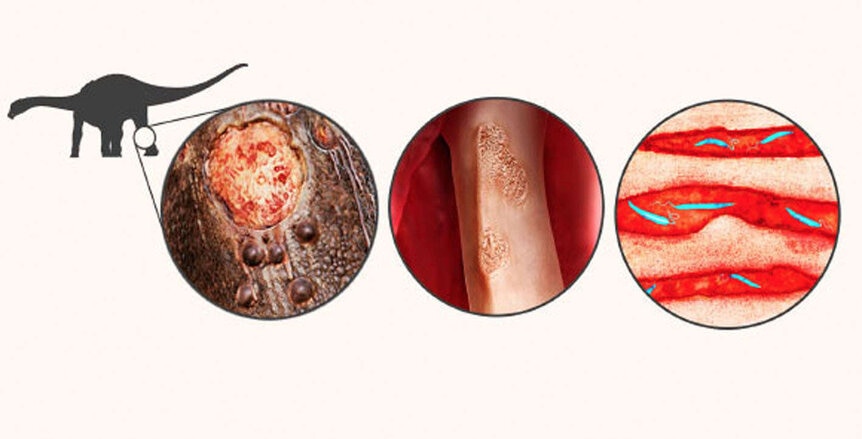Create a free profile to get unlimited access to exclusive videos, sweepstakes, and more!
Even ginormous dinosaurs had this unexpected lethal enemy

Titanosaurs were so enormous that most predators knew better than to risk being trampled—but there was one thing that could take them down, and it didn’t even have teeth.
What may have threatened a titanosaur most was a parasite it couldn’t even see coming. While parasitic life-forms have previously been found in dinosaur coprolites and on dinosaur feathers frozen in amber, this is the first time fossilized parasites have shown up in dinosaur bones. The titanosaur who was their unknowing and probably unwilling host lived almost 83 million years ago. By peering through microscopes and using CT scans to create 3D models of the bones, scientists were able to find these amazingly preserved fossil parasites, which were probably the culprit behind a gargantuan case of osteomyelitis (bone infection) that the beast suffered from until its demise.
This could be the earliest evidence of osteomyelitis in any organism. Paleontology is now trying to bring parasitology, pathology and histology, or the study of tissue micro-structure, together for the first time ever. It could mean titanosaur-size steps towards a further understanding of parasitic infections by seeing how they affected creatures that have long since gone extinct.
"We reported parasites found inside the vascular canals of a dinosaur for the first time ever," paleontologist Tito Aureliano, who co-led a study recently published in Cretaceous Research along with colleague Aline Ghiraldi, told SYFY WIRE. "This opens a new possibility to learn about infectious diseases of the past."
The bone infection and inflammation which the titanosaur in question suffered from seem to have been caused or at least worsened by an invasion of soft-bodied endoparasitic microorganisms (which thrive inside the body) that kept spawning repeatedly and feeding off its bone tissue. Endoparasites like these have never before been dug up with dinosaur bones. Osteomyelitis is thought to have been uncommon in dinosaurs, and few fossils of infected bone ever surfaced. This could either mean that few specimens survived over the eons, that the parasites themselves were not preserved well enough to be observable, or there might still be more that have not yet been excavated. Whether monster lizards were resistant to parasites remains unknown.
"I think it is too early to come out with conclusions about dinos with extra resistance factors," Aureliano said. "It has been several years since paleontologists from around the world started intensifying research on dinosaur diseases. Pathological bones are proportionally rare in the fossil record, and most teams were prioritizing their approaches in different subjects. Since several laboratories worldwide have become aware of these studies, new findings can be expected. We can now return to old fossils in museum collections with a new vision and new technology."
How the parasites started hanging out in the titanosaur’s bones is unclear. Any open wound could have given them an opportunity to burrow into its tissues. Titanosaurs had few threats from predators, especially since so many of them stayed together in massive herds, and their noses could possibly sniff out attackers. Carnivores like Abelisaurus or T. Rex would still try to take a bite sometimes. Microorganisms could easily crawl into the wound and burrow into bone tissue. Parasites may have also broken in through the bloodstream, because along with giant reptiles, there were also things like giant bloodsucking mosquitoes that could spread disease. Mosquitoes evolved during the Jurassic period, so they must have been buzzing around during the Cretaceous when this dinosaur lived.
Parasites multiply like the world is ending*, and even though the world would end for dinosaurs some 20 million years after this one fell, they managed to create enough spawn to infest its enormous skeleton.
"It is possible that osteomyselitis was either caused by the parasites or made it easier for them to infest," Ghiraldi said. "For example, there are infections today in isolated populations in the Amazon that present similar consequences in humans. We are working on a separate research approach to investigate this new species of ancient blood parasites, but those are scenes from the next chapter."
Whatever opened the titanosaur up to parasites, they crawled into its vascular canals and left behind evidence that they invaded. Aureliano and his team suspected osteomyelitis when they examined its periosteum, which is the cell membrane that covers bones. The periosteum appeared highly reactive, meaning it was obvious that it had desperately tried to regrow over and over again as the parasites ravaged it. There was also a warped filigree pattern on the periosteum, more evidence of parasites wriggling around. Inflammation in the tissue that connected bones was also a sign of the severe osteomyelitis that was most likely caused by parasites. At least Aureliano and Ghiraldi feel that the suffering of a Cretaceous dinosaur could possibly help inform parasitology, pathology and histology tens of millions of years later.
"We united these three fields in a single approach for the first time," Aureliano said. "By using histology, we described the advance of an aggressive case of osteomyelitis prior to necrosis. Not even in modern medicine have we seen such a histological description. Osteomyelitis is also a disease that affects animals, including humans, to this day. In parasitology, we basically declared independence from ambers and coprolites. Paleontologists traditionally had to go for insect vectors preserved in amber to look for parasites or look for parasite cysts in coprolites, but in our approach to parasitology, we detached ourselves from ambers and coprolites."
This just goes to show that no matter how huge and imposing you are, you can never be immune to everything.
*Your friendly neighborhood author unfortunately found this out after suffering from a nasty whipworm infection. Never. Ever. Again.




























